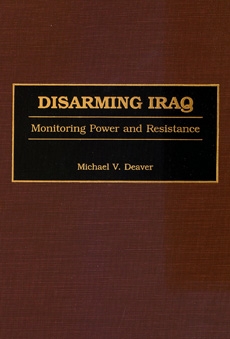| Éditeur : Library of Congress | Date & Lieu : 2001-01-01, America |
| Préface : | Pages : 152 |
| Traduction : | ISBN : 0-275-97261-5 |
| Langue : Anglais | Format : 155x235 mm |
| Code FIKP : Liv. Ang. 1912 | Thème : Politique |
|
Présentation
|
Table des Matières | Introduction | Identité | ||
 Disarming Iraq, monitoring power and resistance Michael V. Deaver is Visiting Lecturer and Academic Coordinator of the Civic Education Project in Russia. He has traveled extensively in the Middle East and has taught courses on international relations and comparative politics in Russia as a Civic Education Project fellow for three years. | |||||
| Table des Matières | ||||
Illustrations Figures 2.1 Characteristics of Relations within Modes of Power / 17 2.2 Tactics and Modes / 19 2.3 Targets of Resistance / 24 4.1 Tactics at the Diplomatic Level / 69 5.1 SCR 687 Disarmament Requirements / 79 5.2 Visibility Tactics and Knowledge Flows in Stage 1 / 83 5.3 Visibility Tactics and Knowledge Flows in Stage 2 / 86 5.4 / Iraqi Tactics Targeting UN Monitoring Tactics / 96 7.1 Ideal Types of Power Relations / 131 Tables 3.1 Iraqi Armed Forces Personnel / 32 3.2 Iraqi Arms Imports / 38 | ||||